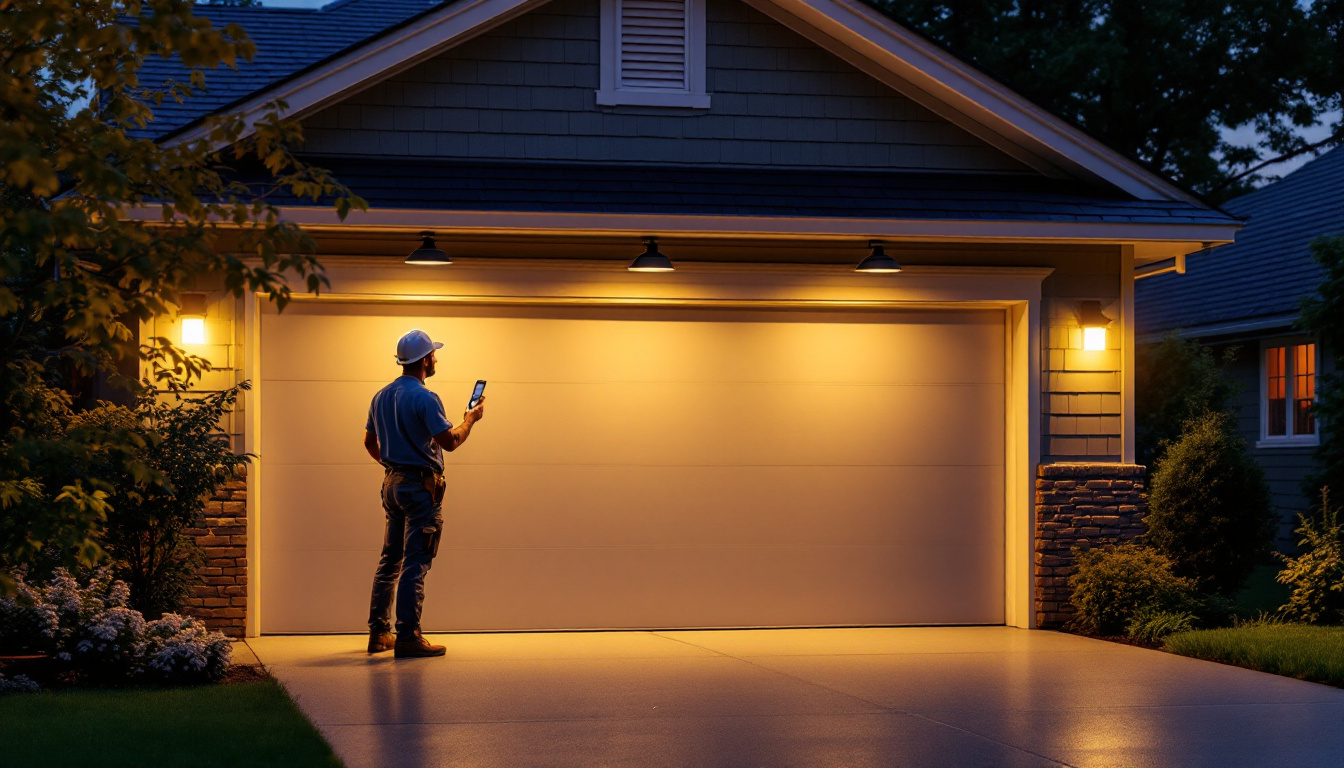
As the demand for energy-efficient lighting solutions continues to grow, LED outdoor garage lights have emerged as a popular choice among homeowners and contractors alike. These lights not only provide superior illumination but also offer durability and cost savings over time. For lighting contractors, understanding the nuances of selecting the right LED outdoor garage lights is essential for meeting client needs and ensuring satisfaction. This guide will delve into the critical factors to consider when choosing LED outdoor garage lights, helping contractors make informed decisions.
LED, or Light Emitting Diode, technology has revolutionized the lighting industry. Unlike traditional incandescent or fluorescent lights, LEDs convert electricity directly into light, making them far more efficient. This efficiency translates into lower energy consumption and longer lifespans, which can be particularly advantageous for outdoor applications. Additionally, the compact size of LEDs allows for innovative designs and versatile installations, enabling them to fit into spaces where traditional bulbs would be impractical.
One of the primary benefits of LED lights is their energy efficiency. They consume significantly less power than traditional lighting options, which can lead to substantial savings on electricity bills. Additionally, LEDs have a longer lifespan, often lasting up to 25,000 hours or more, reducing the frequency of replacements. This longevity not only saves money but also minimizes waste, making LEDs a more environmentally friendly choice compared to their incandescent counterparts.
Another advantage is their durability. LED lights are typically resistant to shocks, vibrations, and extreme temperatures, making them ideal for outdoor environments where they may be exposed to harsh weather conditions. Furthermore, they emit less heat, which can enhance safety in garage settings. This characteristic also contributes to their efficiency, as less energy is wasted as heat. Moreover, many LED products are now designed to be dimmable, allowing users to customize brightness levels according to their needs, further enhancing their versatility.
When selecting LED outdoor garage lights, understanding color temperature and brightness is crucial. Color temperature, measured in Kelvin (K), affects the ambiance and functionality of the space. For example, a cooler color temperature (5000K-6500K) provides a bright, daylight-like effect, ideal for security and visibility. In contrast, warmer temperatures (2700K-3000K) create a more inviting atmosphere, suitable for residential settings. This range of options allows homeowners to tailor their lighting to specific activities, whether it’s working on a project in the garage or simply enjoying a cozy evening outdoors.
Brightness is measured in lumens, and the right level will depend on the specific application. For outdoor garages, a range of 800 to 1600 lumens is generally recommended, providing ample light for tasks while avoiding excessive glare. Furthermore, advancements in LED technology have led to the development of smart lighting solutions that can be controlled via mobile apps or voice commands, adding an extra layer of convenience and customization. These smart systems can adjust brightness and color temperature based on the time of day or specific user preferences, making them an exciting option for modern homes.
Choosing the right LED outdoor garage lights involves several considerations that can impact performance, efficiency, and aesthetics. Contractors must assess the specific needs of the project and the preferences of the homeowner.
The location of the garage and its intended use will significantly influence the choice of lighting. For instance, a garage used primarily for parking may require different lighting than one that serves as a workshop or storage area. Understanding the layout and function of the space will help in selecting fixtures that provide adequate illumination without being overpowering.
Additionally, consider the mounting height and angle of the lights. Higher ceilings may necessitate more powerful fixtures or a different distribution of light to ensure even coverage. Similarly, the orientation of the lights can affect how shadows are cast, which is an important factor for safety and visibility. For example, if the garage is used for detailed tasks like automotive work, brighter, more focused lighting may be essential to avoid accidents and ensure precision.
Moreover, the surrounding environment plays a crucial role in determining the type of lighting needed. For garages located in areas with high foot traffic or near walkways, it may be beneficial to install motion-sensor lights that activate when someone approaches, enhancing both convenience and security. This feature not only provides immediate illumination but also helps conserve energy by ensuring lights are only on when needed.
energy efficiency ratings, such as the Energy Star certification, can guide contractors in selecting high-quality LED products. These ratings indicate that the lights meet specific performance standards, ensuring they are both energy-efficient and reliable. Choosing Energy Star-rated products can also enhance the credibility of the contractor and provide peace of mind to clients.
Furthermore, understanding the wattage and lumens per watt (lm/W) ratio can help evaluate the efficiency of the lights. A higher ratio indicates better energy efficiency, which can contribute to long-term savings for homeowners. Additionally, it’s worth considering the lifespan of the LED bulbs, as many can last up to 25,000 hours or more, significantly reducing the frequency of replacements and maintenance costs over time.
Incorporating smart technology can further elevate energy efficiency. Smart LED lights can be controlled via apps or home automation systems, allowing homeowners to adjust brightness levels, set schedules, and even change colors to suit different occasions. This not only maximizes energy savings but also adds a layer of convenience and customization to the lighting experience.
The design of the LED outdoor garage lights should complement the overall aesthetics of the property. There are various styles available, from sleek and modern fixtures to more traditional designs. Contractors should consider the architectural style of the garage and surrounding areas when making recommendations.
Additionally, the finish and color of the fixtures can impact their visual appeal. Options such as matte black, brushed nickel, or white can enhance the look of the garage while providing functional lighting. It’s essential to strike a balance between aesthetics and practicality to ensure client satisfaction. For instance, decorative fixtures can add character to the garage while still delivering the necessary brightness for tasks.
Furthermore, the placement of the lights can create a dramatic effect, enhancing the overall ambiance of the garage area. Layered lighting, which combines ambient, task, and accent lighting, can transform a simple garage into a versatile space that is not only functional but also visually appealing. By incorporating dimmable options or adjustable fixtures, contractors can offer clients the flexibility to adapt the lighting to various activities or moods, making the garage a more inviting space overall.
Proper installation is critical to maximizing the performance and longevity of LED outdoor garage lights. Contractors must be aware of various factors that can affect installation, including electrical requirements, fixture placement, and local codes.
Before installation, it’s vital to assess the electrical requirements of the LED fixtures. Most LED lights operate on standard voltage, but some may require specific transformers or drivers. Understanding these requirements will help prevent compatibility issues and ensure safe operation.
Moreover, contractors should consider the existing wiring and circuit capacity. In some cases, upgrades may be necessary to accommodate the new lighting system, which can involve additional costs and time. Ensuring that the electrical system is up to code is essential for safety and compliance.
Strategic placement of fixtures can significantly enhance the effectiveness of outdoor garage lighting. Contractors should aim for even light distribution to minimize shadows and dark spots. This can be achieved by using multiple fixtures or adjusting the angle of the lights.
Additionally, consider the height at which the lights will be mounted. Higher fixtures may provide broader coverage, but they can also create shadows. Finding the right balance will ensure optimal visibility and safety for users.
Local building codes and regulations can vary significantly, and it’s essential for contractors to be familiar with these requirements. Compliance with codes not only ensures safety but can also prevent costly fines or the need for rework.
Contractors should check for any specific regulations regarding outdoor lighting, including restrictions on brightness, fixture types, and energy efficiency standards. Staying informed about local codes will help streamline the installation process and enhance the contractor’s reputation.
While LED lights are known for their durability and long lifespan, regular maintenance is still necessary to ensure optimal performance. Contractors should educate clients on proper care and maintenance practices to extend the life of their outdoor garage lighting.
Dust, dirt, and debris can accumulate on fixtures over time, diminishing their brightness and effectiveness. Regular cleaning is essential to maintain optimal light output. Contractors should recommend appropriate cleaning methods and products that will not damage the fixtures.
Additionally, it’s important to check for any signs of wear or damage, such as flickering lights or discoloration. Addressing these issues promptly can prevent further problems and ensure the longevity of the lighting system.
As technology continues to evolve, upgrading to newer LED fixtures may become necessary to take advantage of improved efficiency and features. Contractors should stay informed about the latest advancements in LED technology and be prepared to recommend upgrades when appropriate.
Replacing outdated fixtures can enhance the overall lighting quality and energy efficiency of the garage. Educating clients about the benefits of upgrading can lead to additional business opportunities for contractors.
Choosing the right LED outdoor garage lights requires careful consideration of various factors, from understanding LED technology to installation and maintenance. By staying informed about the latest advancements in lighting solutions, contractors can provide clients with high-quality, energy-efficient options that meet their specific needs.
Ultimately, the goal is to create a well-lit, safe, and aesthetically pleasing environment for homeowners. By following the guidelines outlined in this article, lighting contractors can enhance their expertise and deliver exceptional service, ensuring satisfied clients and successful projects.
Ready to elevate your lighting game? At LumenWholesale, we provide lighting contractors like you with the finest LED outdoor garage lights that combine quality, efficiency, and affordability. Say goodbye to local distributor markups and hello to our spec-grade lighting products at wholesale prices. With our commitment to excellence and hassle-free bulk buying with free shipping, you can trust that you’re getting the best value for your investment. Don’t compromise on your lighting needs—discover wholesale lighting at the best value today and light up your projects with confidence.
Discover how Guard Light revolutionizes the workflow of lighting contractors by enhancing efficiency and precision.

Unlock the essentials of the Candelabra Base Type B bulb in just 5 minutes.

Discover the essential guide for lighting contractors on selecting the perfect extra large wall sconces.

Discover essential tips and strategies for lighting contractors to navigate common challenges with 4-foot LED installations.